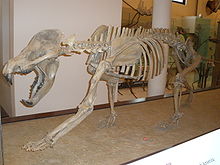Loading AI tools
Extinct family of carnivores From Wikipedia, the free encyclopedia
Amphicyonidae is an extinct family of terrestrial carnivorans belonging to the suborder Caniformia. They first appeared in North America in the middle Eocene (around 45 mya), spread to Europe by the late Eocene (35 mya), and further spread to Asia and Africa by the early Miocene (23 mya). They had largely disappeared worldwide by the late Miocene (5 mya), with the latest recorded species at the end of the Miocene in Africa. They were among the first carnivorans to evolve large body size. Amphicyonids are colloquially referred to as "bear-dogs".[1]
| Amphicyonids | |
|---|---|
 | |
| Skeleton of Amphicyon | |
| Scientific classification | |
| Domain: | Eukaryota |
| Kingdom: | Animalia |
| Phylum: | Chordata |
| Class: | Mammalia |
| Order: | Carnivora |
| Suborder: | Caniformia |
| Superfamily: | †Amphicyonoidea |
| Family: | †Amphicyonidae Haeckel, 1866 |
| Subfamilies | |
|
†Amphicyoninae | |

The family was erected by Haeckel in 1866 (also attributed to Trouessart 1885). Their exact position has long been disputed. Some early paleontologists defined them as members of the family Canidae, but the modern consensus is that they form their own family. Some researchers have defined it as the sister clade to ursids (bears), based on morphological analysis of the ear region.[2][1] However, cladistic analysis and reclassification of several species of early carnivore as amphicyonids has strongly suggested that they may be basal caniforms, from lineages older than the origin of both bears and dogs.[3][4][5]
Amphicyonids ranged in size from as small as 5 kg (11 lb) and as large as 100 to 773 kg (220 to 1,704 lb)[6] and evolved from wolf-like to bear-like body forms.[7]
Early amphicyonids, such as Daphoenodon, possessed a digitigrade posture and locomotion (walking on their toes), while many of the later and larger species were plantigrade or semiplantigrade.[8] The amphicyonids were obligate carnivores, unlike the Canidae, which are hypercarnivores or mesocarnivores.[9]
There is often some confusion with the similar looking (and similarly named) "dog-bears", a more derived group of caniforms that is sometimes classified as a family (Hemicyonidae), but is more often considered a primitive subfamily of ursids (Hemicyoninae).

It has long been uncertain where amphicyonids originated. It was thought that they may have crossed from Europe to North America during the Miocene epoch, but recent research suggests a possible North American origin from the miacids Miacis cognitus and M. australis (now renamed as the genera Gustafsonia and Angelarctocyon, respectively). As these are of North American origin, but appear to be early amphicyonids, it may be that the Amphicyonidae actually originates in North America.[3]
Other New World amphicyonids include the oldest known amphicyonid, Daphoenus (37–16 Mya).
Amphicyonids began to decline in the late Miocene, and disappeared by the end of the epoch. The exact reasons for this are unclear. The most recent known amphicyonid remains are teeth known from the Dhok Pathan horizon, northern Pakistan, dating to 7.4-5.3 mya.[10] The species is classically named Arctamphicyon lydekkeri, which may actually be synonymous with a species of Amphicyon.[11]
Fossils of juvenile Agnotherium, Ischyrocyon, and Magericyon all show an unusual type of tooth eruption in which there is a vulnerable stage at about two or three years of age where the subadult animal has no functional molar or carnassial teeth, the only functional cheek teeth being several milk premolars.[12] This period was suggested to be "presumably short" but would have made it very difficult for the animal to process food.[13] This type of tooth replacement is not seen in similar carnivorans like ursids or canids, and may have been one factor in the extinction of the Amphicyonidae.
Family Amphicyonidae
| Not assigned to a subfamily | Subfamily Amphicyoninae | Subfamily Haplocyoninae (Eurasia)[14][15] |
Subfamily Daphoeninae (North America) |
Subfamily Temnocyoninae (North America)[16] |
Subfamily Thaumastocyoninae[17] |
|---|---|---|---|---|---|
|
|
|
|
|
|
Seamless Wikipedia browsing. On steroids.
Every time you click a link to Wikipedia, Wiktionary or Wikiquote in your browser's search results, it will show the modern Wikiwand interface.
Wikiwand extension is a five stars, simple, with minimum permission required to keep your browsing private, safe and transparent.